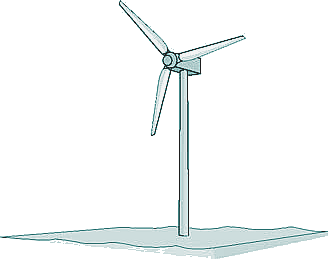GCSE Questions: Energy Sources Q8. The sketch below shows a wind turbine.
(a) At a particular wind speed, a volume of 2.3 × 104 m3 of air passes the blades each second. The density of air is 1.2 kg/m3. Calculate the mass of air passing the blades per second. ρ = m/V m = ρV m = 1.2 x 2.3 × 104 m = 2.76 × 104 [3 marks] (b) The power output of the turbine is directly proportional to the kinetic energy of the air passing the blades each second. Describe the effect on the power output when the wind speed is halved.
The mass of air passing the turbine blades will be halved, which decreases kinetic energy transfer by a factor of two as 'm' is halved. Kinetic energy is related to the square of the speed - so as (½v)2 = ¼v2 if the wind speed is halved the kinetic energy of the air drops to a quarter of its value because of the velocity change. Therefore the overall change will be a drop in energy transfer of a factor of 8 [3 marks] (c) At a different wind speed, the wind turbine has a power output of 388 kW. The mass of air passing the wind turbine each second is 13,800 kg. Calculate the speed of the air passing the blades each second. Assume that the process is 100% efficient. 388 kW = 388 x 103 J/s In one second m = 13,800 kg Ek = 388 x 103 J Ek = ½mv2 v2 = 2Ek /m v2 = (2 x 388 x 103)/13,800 v2 = 56.23 v = 7.50 [4 marks] (Total 10 marks) |
Follow me...
|






